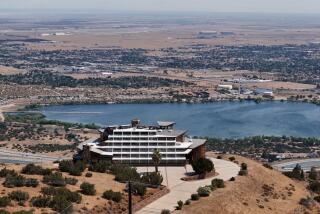A father and son’s La Jolla masterpiece wins top architectural award
- Share via
What the eye doesn’t see — empty space — is correlative to what it does see.
Architect Rudolph Schindler grasped this deceptively simple perceptual law in spades, creating buildings of pure grace. No wonder, then, that a La Jolla residence built by architect-developer Jonathan Segal has drawn so many Schindler comparisons.
An American Institute of Architects San Diego jury also referred to Schindler when awarding the three-bedroom home (build cost: $1.55 million) its sole “honor award” last month.
“We used the most simple gesture to get the job done,” said Segal, who, sharing design credit with son Matthew, completed the 5,300-square-foot home in 2014 after nine months of construction. “If we could have removed more, we would have.”
Indeed, this is architecture by subtraction.
The Segals began with a simple rectangle box sketched on paper, erasing plane after plane until left with mere suggestion: the implied shape of an adjacent patio, a vast exterior room. The area is delineated by a few brush strokes — concrete supports that faintly outline the area, its roof nothing less than a framed sky.
The L-shaped interior (two stories above ground, one below) cradles all that negative space, mirrored by an L-shaped pool at the front that the home appears to float on. Built of cast-in-place concrete sheathing floor-to-ceiling glass, the home embodies a gravitas shot through with light — warmed by flooring and built-ins of California walnut.
Wood form casts were used to riddle the concrete with holes, grain and tone gradations, a “rude, nasty, unfinished look in contrast to the pristine walnut and glass,” said Jonathan Segal, 56.
The coarse surfaces further marry the structure (its glass walls recede, creating an open-air pavilion) to nearby bluffs and, 80 yards away, the crashing ocean.
Sweeping cantilevers that appear razor-thin shield the inset glass walls; a 50-foot beam that spans the patio is just 8 inches thick, made possible by the concrete construction.
Since building the home, the Segals, in fact, have shunned wood-frame construction.
“These kind of cantilevers just weren’t practical or feasible with wood,” said Matthew Segal, 30, a recent graduate of USC School of Architecture.
Other notable features: the generous 2,000-square foot basement lit by lengthy strips of skylight, a rooftop 6.5-kilowatt solar array and the skinny 5,000-square-foot lot. Adjacent properties are about four times that size, noted the American Institute of Architects, extolling the Segals’ efficient use of space.
The home’s sole decorative feature is a 9-foot-tall safety gate created by Christopher Puzio that separates the lap pool from the front reflecting pool. The portal’s jagged design is artfully mirrored in the water and casts exceptional shadows.
The home sold last month for $5.5 million.
A neighborhood comparison: In the home’s 92037 ZIP Code, based on 615 sales, the median sales price for single family homes this year through September was $1.178 million, up 12.2 % over the same period a year earlier, according to CoreLogic.
MORE FROM HOT PROPERTY
L.A.’s most expensive place to live boils down to how many bedrooms you need
Publicist to the stars Jeffrey Lane records a quick sale at the Shoreham Towers
Former Charger Mike Tolbert hands off his Mediterranean-style home in San Diego
More to Read
Sign up for Essential California
The most important California stories and recommendations in your inbox every morning.
You may occasionally receive promotional content from the Los Angeles Times.






